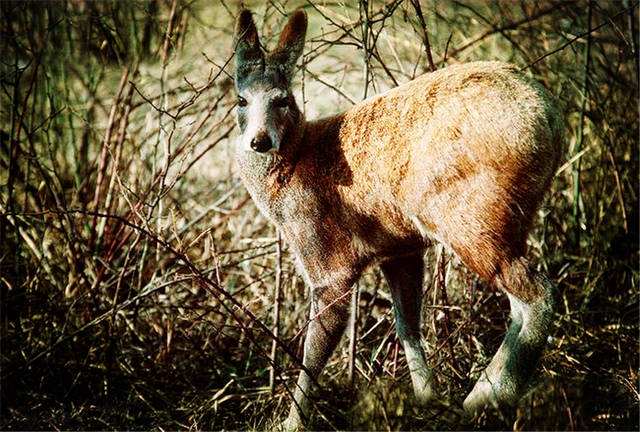Musk deer
IUCN
LCBasic Information
Scientific classification
- name:Musk deer
- Scientific Name:Moschus moschiferus
- Outline:Ungulata
- Family:Artiodactyla Moschidae Moschus
Vital signs
- length:65-95cm
- Weight:8-13kg
- lifetime:Up to 17 years in captivity
Feature
"Forest Fragrant Concubine"
Distribution and Habitat
Distributed in China, Kazakhstan, the Democratic People's Republic of Korea, South Korea, Mongolia, and the Russian Federation.
In China, it is distributed in Hebei, Beijing, Heilongjiang, Jilin, Liaoning, Inner Mongolia, Shanxi, and Xinjiang.
Musk deer live mostly in cliffs and rocky mountain habitats in coniferous and broadleaved mixed forests, coniferous and deciduous forests, coniferous mixed forests, and sparse forests and shrubs, and sometimes migrate vertically depending on the season.
Appearance
The original musk deer has a small head, big eyes, long and upright ears, a nearly round upper part, and an exposed snout. Both sexes have no horns, and the male's upper canine teeth are well developed and exposed outside the lip to form tusks. The female's upper canine teeth are small and not exposed outside the mouth. The limbs are slender, the hind limbs are longer than the forelimbs and more developed than the forelimbs, the hip height is greater than the shoulder height, and the rear part of the body is thick. The main hoof is narrow and long, and the side hoofs are prominent and can touch the ground. The tail is short and hidden in the hair. Males have musk glands on their abdomen that secrete musk. The size of the glands varies from individual to individual and the glands are cystic in shape.
The whole body is dark brown, with cinnamon-colored spots arranged in 4-5 vertical rows on the back, abdomen and buttocks. The spots on the back are not obvious, and the spots
Details
The Taiga Musk Deer has three subspecies and is a small mammal.

Musk deer often move alone, or females and their offspring form a family, and are generally more active at dawn and dusk. In summer, they live mostly on steep cliffs near rocky cliffs and river valleys; in winter, they prefer to live in places that are sheltered from the wind and facing the sun. Musk deer are mountain animals that can move briskly and swiftly on steep cliffs. In dense forests, they often walk on fallen trees and have the habit of climbing slanting trees. They are very good at jumping. They have well-developed vision and hearing. They often stop on the top of the rocky cliffs and look around. They will quickly escape when there is any special movement. When in danger, they often hide in the crevices of rocks.
Musk deer have relatively fixed activity and foraging routes leading to their habitats, and their activity range is also relatively fixed. Both male and female individuals have developed tail sebaceous glands. On the routes they often travel, they actively rub their gland secretions on fixed wooden stakes, rocks or protruding parts of tree trunks to mark the boundaries of their territory. They usually only move within the marked area and have a strong attachment to their habitats.
Musk deer are in estrus from October to January of the following year, with the peak period in November and December. During this period, males fight fiercely for females and fight with each other with their canine teeth. The gestation period is 5-6 months, and the offspring are born in June and July, with 1-2 babies per litter, mostly 2 babies, and the lactation period is about 2 months. Newborn babies cannot stand and lie in a hidden place. The mother musk deer regularly comes to breastfeed and take care of them. After 1 month, they can eat a small amount of tender branches and leaves. Musk deer grow and develop rapidly. Females reach sexual maturity at the age of 2, and males generally reach 3 years old.
Between 1920 and 1930, the number of Musk deer decreased significantly due to hunting. Around 1970, the number of musk deer in Mongolia was about 60,000-80,000; in 1986, the Institute of Biology of the Mongolian Academy of Sciences estimated that the population of musk deer was about 44,000; from 1990 to 2000, the population density of this species in Mongolia dropped to 5-6/km². In 1999, the Fisheries and Wildlife Bureau of Sakhalin Island estimated that there were about 600-650 musk deer, and the number was still declining; there were about 27,000-30,000 in East Siberia, and as many as 150,000 in the Russian Far East. In 2011, the total data of this species in 10 federal regions of Siberia was estimated to be about 110,000. The overall population of musk deer is on a downward trend. Musk deer are only distributed in the Helan Mountains in Inner Mongolia Autonomous Region of China. In a survey in 1996, there were still more than 250; the survey results around 2008 showed that its number had rebounded significantly, and the specific number remains to be verified.
Listed in the 2015 Red List of Endangered Species of the World Conservation Union (IUCN) ver 3.1 - Vulnerable (VU).
Listed in the first level of the "List of National Key Protected Wildlife in China".
Protect wildlife and eliminate game.
Maintaining ecological balance is everyone's responsibility!








